The molecular weight, molecular weight distribution and size of three common polymers are measured using OMNISEC. This information can provide insight into the physical properties and behavior of these synthetic polymers.
The physical properties and behavior of polymers depends strongly on the properties of the polymer molecules themselves. Molecular weight and molecular weight distribution, molecular size and structure all affect how the material will behave. By understanding and controlling these properties, polymer manufacturers can control polymer production and quality. Historically, accurate measurement of polymer molecular weight has been dependent on having standards of the same polymer but the introduction of advanced detection techniques such as light scattering and intrinsic viscosity have made absolute measurements possible.
Malvern’s OMNISEC system is a completely new multi-detector GPC system that combines light scattering, refractive index (RI), ultraviolet (UV) and intrinsic viscosity (IV) detectors to generate a large amount of information about a sample simultaneously. Its new design means it is capable of making these measurements with less sample and lower molecular weights than ever before.
GPC/SEC (gel-permeation or size-exclusion chromatography) is the most commonly used tool for assessing these parameters. The principle of GPC involves separating the sample as it travels through a porous but inert column matrix. While smaller molecules penetrate the pores more deeply, larger molecules are excluded and thus travel through the column faster. The result is a separation based on hydrodynamic volume. However, in most cases, the desire is to know the molecular weight of the sample.
In this application note, the molecular weight, molecular weight distribution and size of three common polymers are measured using the OMNISEC system.
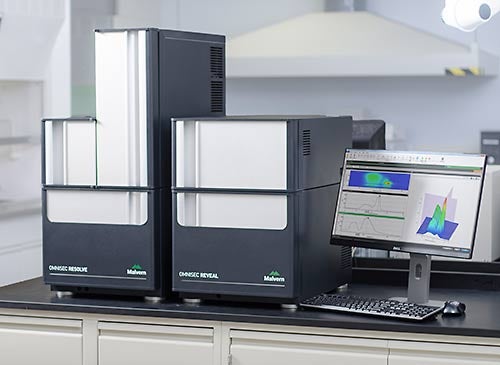
|
The OMNISEC system was set up as follows:
Samples were separated using two Viscotek T6000M columns. The mobile phase was THF stabilized with 300 ppm BHT. Samples were allowed to dissolve overnight to ensure full dissolution. The detectors and columns were all held at 35 °C to ensure a good separation and maximize baseline stability.
The three samples analyzed in this note are a broad distribution polystyrene (PS) sample, a broad distribution polymethylmethacrylate (PMMA) and a polyvinylchloride (PVC). All three were dissolved in the mobile phase and then run through the system. Their molecular weights were measured using the new OMNISEC system.
A chromatogram of the polystyrene sample with high polydispersity is shown in Figure 2A. The table shows the measured MW, which is determined by the light scattering detector to be 249.7 kDa. The RI chromatogram overlaid with the molecular weight distribution is shown in 2C. Figure 2D shows an overlay of the molecular weight distribution of two replicate injections for the polystyrene sample which shows the excellent reproducibility of the light scattering data.
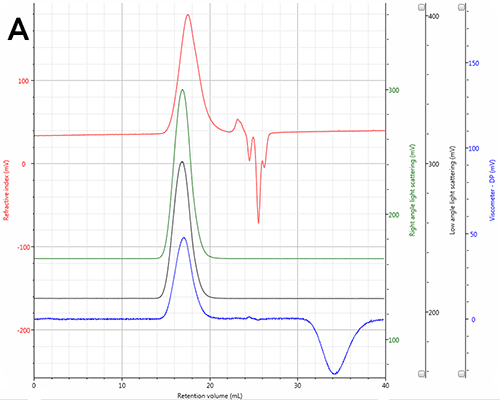
|
| Parameter | Polystyrene |
|---|---|
| Mn (Da) | 108,900 |
| Mw (Da) | 249,770 |
| PD (Mw/Mn) | 2.294 |
| Intrinsic viscosity (dL/g) | 0.814 |
| Rhw (nm) | 13.90 |
|
|
A sample of PMMA was dissolved in the mobile phase and separated on the system. Figure 3A shows its chromatogram, and the molecular weight results are shown in the table. The OMNISEC system has measured the absolute molecular weight to be 89.4 kDa.
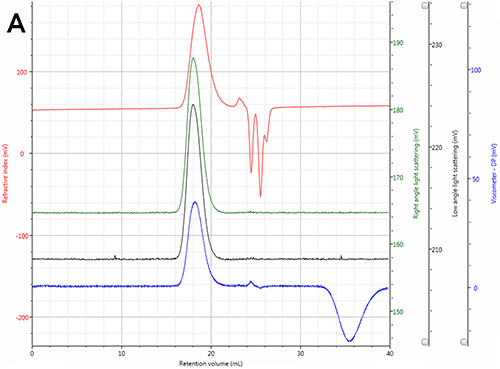
|
| Parameter | Polymethylmethacrylate |
|---|---|
| Mn (Da) | 431,670 |
| Mw (Da) | 89,440 |
| PD (Mw/Mn) | 2.072 |
| Intrinsic viscosity (dL/g) | 0.361 |
| Rhw (nm) | 7.64 |
A sample of PVC was dissolved in the mobile phase and separated on the system. Figure 4A shows its chromatogram, and the molecular weight results are shown in the table, with the absolute MW measured as 227 kDa.
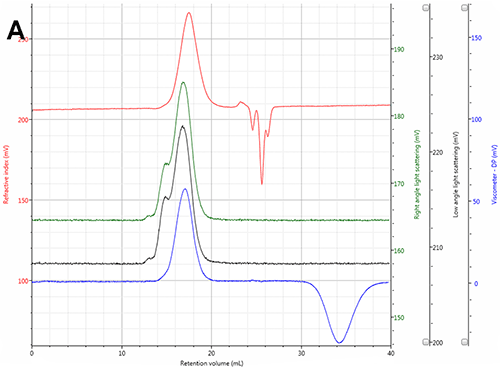
|
| Parameter | PVC |
|---|---|
| Mn (Da) | 112,240 |
| Mw (Da) | 227,090 |
| PD (Mw/Mn) | 2.023 |
| Intrinsic viscosity (dL/g) | 1.353 |
| Rhw (nm) | 15.53 |
Figure 5 shows a molecular weight distribution overlay of PS (red & purple), PMMA (green & black) and PVC (blue and tan). Note that on this graph the plot represents the weight fraction vs. molecular weight, and on the x-axis the molecular weight increases from left to right. The peaks are polydisperse, as shown by the polydispersity value (MW / Mn), indicating that the range of molecular weights within these peaks is broad.
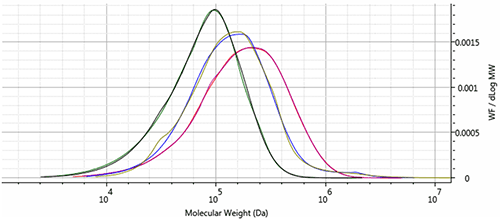
|
This application note has described how OMNISEC can accurately measure the absolute molecular weight of any polymers independent of elution volume or structure, using PS, PMMA and PVC as examples. Although the measurements here have been performed using simple polymers, these methods can be applied to any polymer measured by GPC/SEC. Conventional chromatography systems, calibrated with molecular weight standards, cannot accurately measure the molecular weights of these samples unless they had been calibrated with the appropriate molecular weight standards for each different sample. This may be possible for more common polymers such as PS or PMMA, where narrow standards kits are available, but it certainly would not be possible for even slightly exotic polymers or for novel polymers during research or development. Accurate molecular weights such as these are can only be measured with a light scattering based system such as OMNISEC.
With this kind of accurate information, polymer manufacturers can exert far greater control over the research, development and manufacturing process of the polymers they are producing. This enables production of higher quality product, better grading and reduces quality issues associated with production. In turn, these improvements correspond to increased company competitiveness and better product performance.